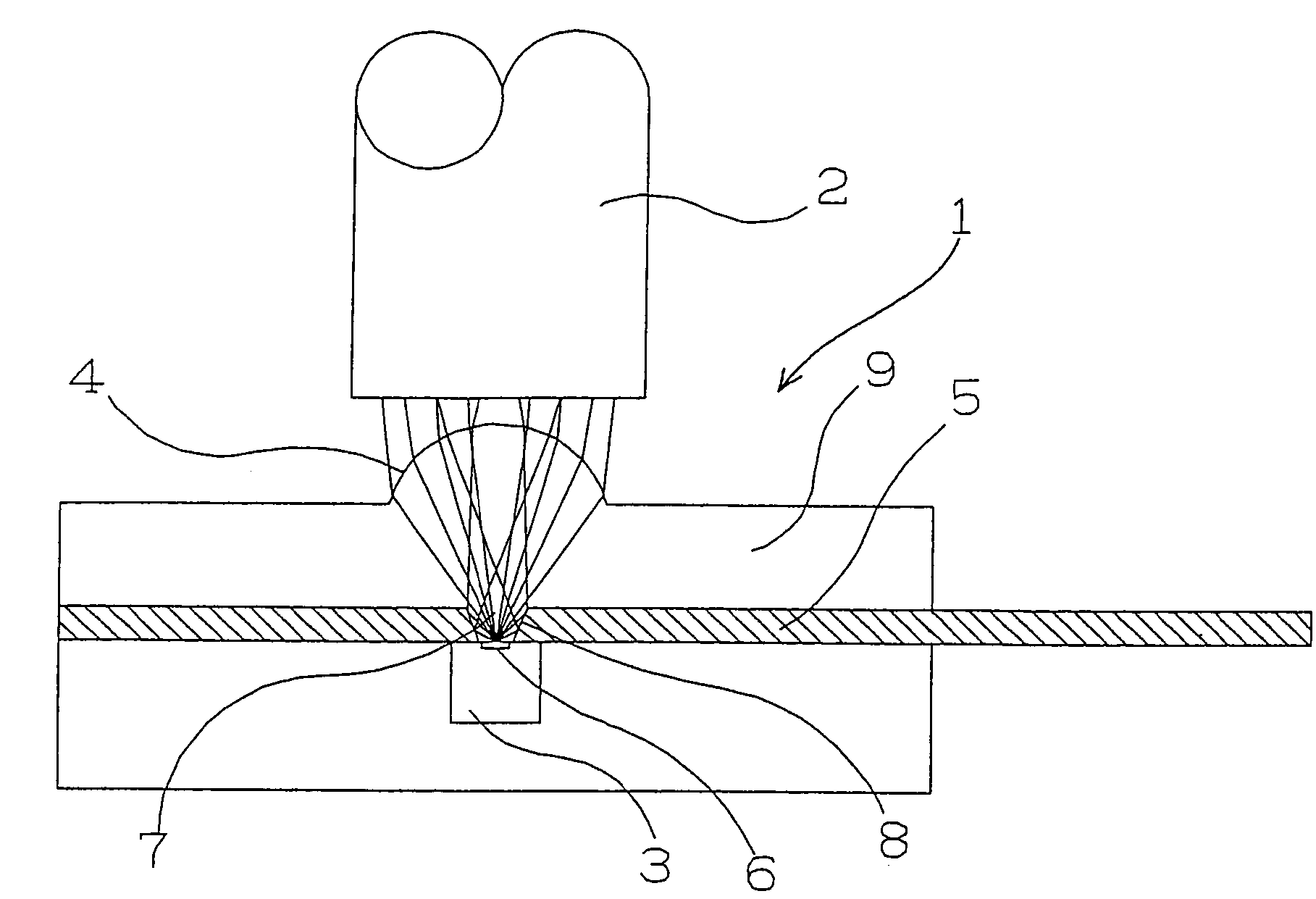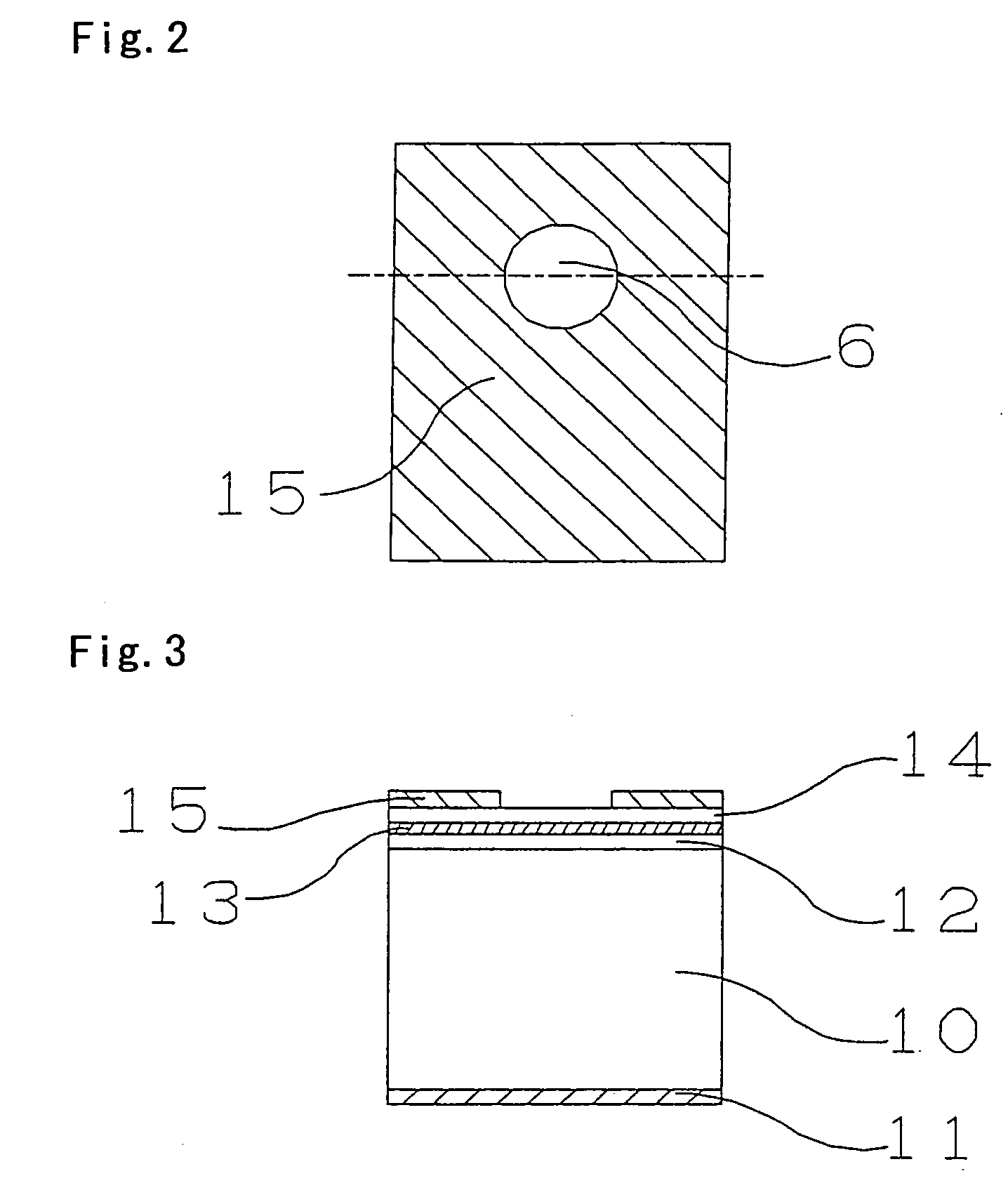Optical transmitter
a technology of optical transmitters and optical beams, applied in the field of optical transmitters, can solve the problems of difficult to increase the coupling efficiency, difficult to couple light beams, and failure to ensure in the direction of the thickness of the optical transmitter, so as to reduce the number of components and simplify the production process. , the effect of increasing the coupling efficiency
- Summary
- Abstract
- Description
- Claims
- Application Information
AI Technical Summary
Benefits of technology
Problems solved by technology
Method used
Image
Examples
embodiment 1
[0111]FIG. 1 is an explanatory view showing a schematic construction of an optical transmitter according to Embodiment 1 of the present invention.
[0112]The optical transmitter 1 comprises a light-emitting element 3, a lens 4 and a lead frame (substrate) 5 disposed on the light-emitting element 3.
[0113]The lead frame 5 has a through hole 7 formed in a position facing a light-emitting surface (light-emitting portion) 6 of the light-emitting element 3. The through hole 7 is tapered so that its inside diameter gradually increases from a rear surface side, on which the light-emitting element 3 is disposed, toward a front surface side. The tapered through hole 7 has an inner wall called a taper mirror 8.
[0114]Of light beams radiated from the light-emitting element 3, a light beam having a narrow radiation angle passes through the through hole 7 and enters the lens 4 to be refracted and coupled into an optical fiber 2. A light beam having a wide radiation angle of the light beams radiated ...
embodiment 2
[0180]A modification of the above optical transmitter according to Embodiment 1 is given as an optical transmitter according to Embodiment 2 and explained referring to FIG. 14. FIG. 14 is an explanatory view showing a schematic structure of the optical transmitter according to Embodiment 2.
[0181]As shown in FIG. 14, in the optical transmitter 21 according to Embodiment 2, the lens 4 is not formed of the mold resin (encapsulating resin member) 9. The mold resin 9 covers only the rear surface side of the lead frame 5 on which the light-emitting element 3 is disposed. The light-emitting element 3 and a driver IC 19 are encapsulated in the mold resin 9 and protected from outside air. The light-emitting element 3 and the driver IC 19 are electrically connected together with a bonding wire 33 (though in the reality there are a plurality of bonding wires 33, omission is made in the figure).
[0182]The lens 4 can be a ball lens made of a glass, an acrylic resin or the like. The ball lens as t...
embodiment 3
[0187]Another modification of the above optical transmitter according to Embodiment 1 is given as an optical transmitter according to Embodiment 3 and explained referring to FIG. 15. FIG. 15 is an enlarged view of an essential part of the optical transmitter according to Embodiment 3.
[0188]As shown in FIG. 15, in the optical transmitter 31 according to Embodiment 3, the through hole 7 is of the shape shown in FIGS. 10 and 11.
[0189]A light beam emitted from the light-emitting element is reflected from the taper mirror portion 8, without being applied onto the inner wall of the enlarged hole portion 17, so that the optical path of the light beam is changed.
[0190]As aforementioned, this constitution allows the lead frame 5 to have an increased thickness so that heat dissipation is improved, and further that the effect of the mold resin (light-transmissive resin member) 9 or the adhesive (transparent resin) 16 easily flowing into the through hole 7 can be obtained.
[0191]Also, the light-...
PUM
 Login to View More
Login to View More Abstract
Description
Claims
Application Information
 Login to View More
Login to View More - R&D
- Intellectual Property
- Life Sciences
- Materials
- Tech Scout
- Unparalleled Data Quality
- Higher Quality Content
- 60% Fewer Hallucinations
Browse by: Latest US Patents, China's latest patents, Technical Efficacy Thesaurus, Application Domain, Technology Topic, Popular Technical Reports.
© 2025 PatSnap. All rights reserved.Legal|Privacy policy|Modern Slavery Act Transparency Statement|Sitemap|About US| Contact US: help@patsnap.com



